The Waxing Earth
Thumbnails Followed by Paintings and their Explanations that Delve into the Discoveries and Ideas Behind the Paintings



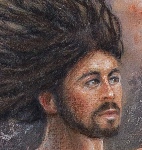
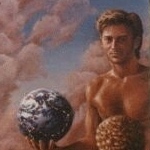
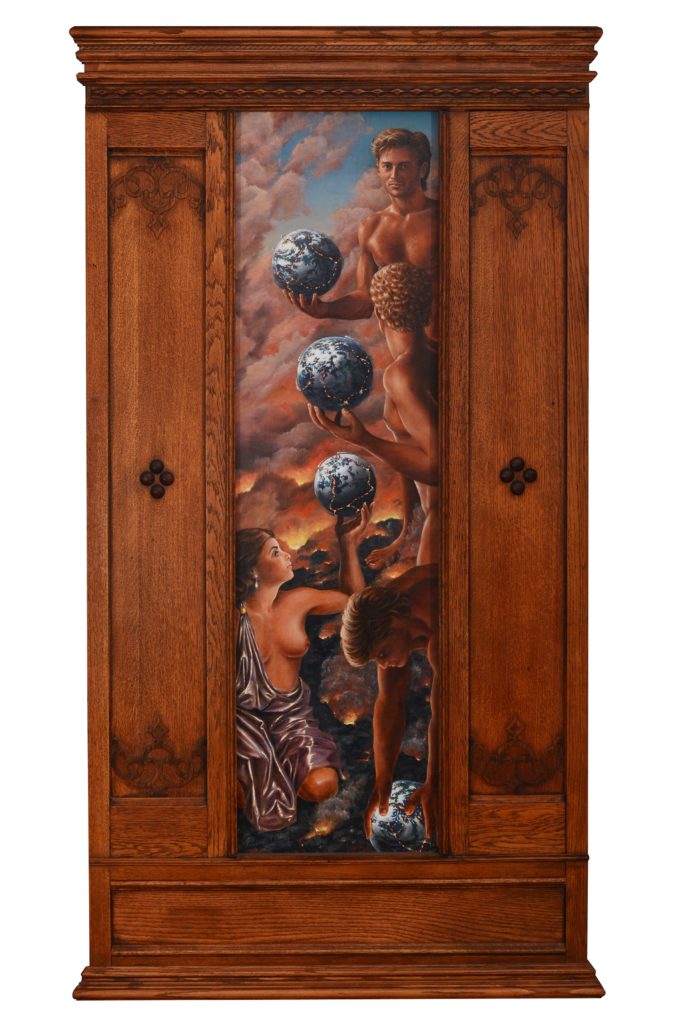
Titan's π
Titan's
This video shows that our continents are pieces of a three-dimensional jigsaw puzzle and can perfectly cover a smaller globe. This result is not a coincidence and proves that the Earth has changed its size. In addition, the smaller globe shows that the relative positions of today’s continents and their orientation changed as they moved from their original positions.
The painting “Titans Pie” shows four Titans molding the Earth. They had been working for billions of years. The Earth was still an endless ocean. However, the ocean floor was a jigsaw puzzle of faults and volcanic activity continents. But in this maze of lines, we can recognize the continents. The Earth is expanding, and the continents are slowly separating. They will rise above the ocean as it sinks into the spaces made as they move apart.
Building A Model Of The Past
Making the model did not change the outline of the continents or significant islands. First, of course, tracings were made of continents that included continental shelves. Next, these tracings were then applied manually to the small globe.
Photos Of The Steps In Building the Model
The images read vertically, first show a continent on the globe. The second image below shows the completed tracing of the continent. Beneath this image is the transfer of the tracing to the more miniature globe. The bottom photo shows the continent on the smaller Earth.
Note that the photos on the right-hand side omit the islands too small to be seen easily.

The Size Comparison
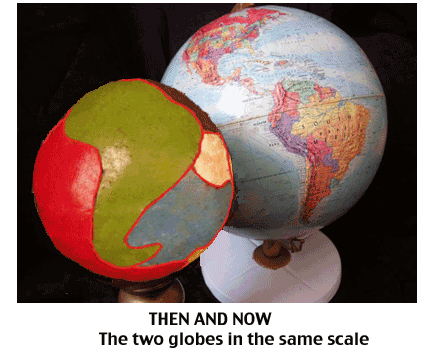
These two globes vividly illustrate the dramatic transformation of our planet, with the left globe depicting the Earth eons ago and the right globe showcasing its present state.
The Continent Are Always Moving
Geologists recognize that Earth’s continents are moving slowly across the planet’s surface, typically at a rate of a few centimeters a year. However, sometimes, continents can shift suddenly to a new position. These rapid movements vary in strength and magnitude and have occurred at variable intervals of approximately 60, 250, and 400 million years.
Many geological formations provide evidence of these shifts in the Earth’s surface. For instance, we can see chains of folded mountains, extensive areas of pillow lava covering thousands of square miles on the ocean floor, and vast expanses of metamorphic rock. As the continents move, they scrape sediments from the ocean floor. The leading edge of the continent crumples and, in turn, builds up mountains. The continents show similar results, such as a car going off the road and crumpling its hood or bonnet.
Scientists can determine the timing and direction of the rapid shifts in continents’ positions by analyzing the age of the metamorphic rock that was once part of the leading edge of a continent’s movement. Mountains also form when two or more continents collide, as with the Himalayas or the Caucasus. In such collisions, one continent will ride up over the other for miles, creating significant mountain ranges and giving the impression that one of the continents is plunging into the Earth. This process leads to the formation of metamorphic rock as well.
The continents sit on a layer beneath the crust, with the ocean floor being an extension of this layer covered by layers of sediment. Expansion faults riddle this layer. Caused by the Earth’s expansion, they circle the globe.
One prominent example is the San Andreas Fault, part of the Pacific Ring of Fire. Expansion faults are the location of the majority of the volcanic activity on Earth. The faults that are perpendicular to the expansion are radial. The Earth may seem solid, but especially below the surface of the Earth, even the rocks behave somewhat like sand or a fluid. This fluidity is essential when considering the tension between the Earth’s surface at the equator, which is 1000 miles an hour, while at the poles and the central axis, the Earth’s speed is almost nil, creating these radial faults.
Fault Lines On The West Coast
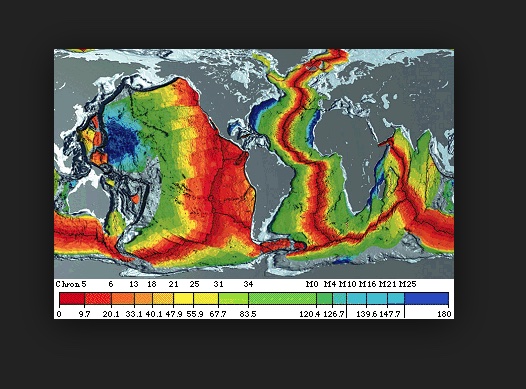
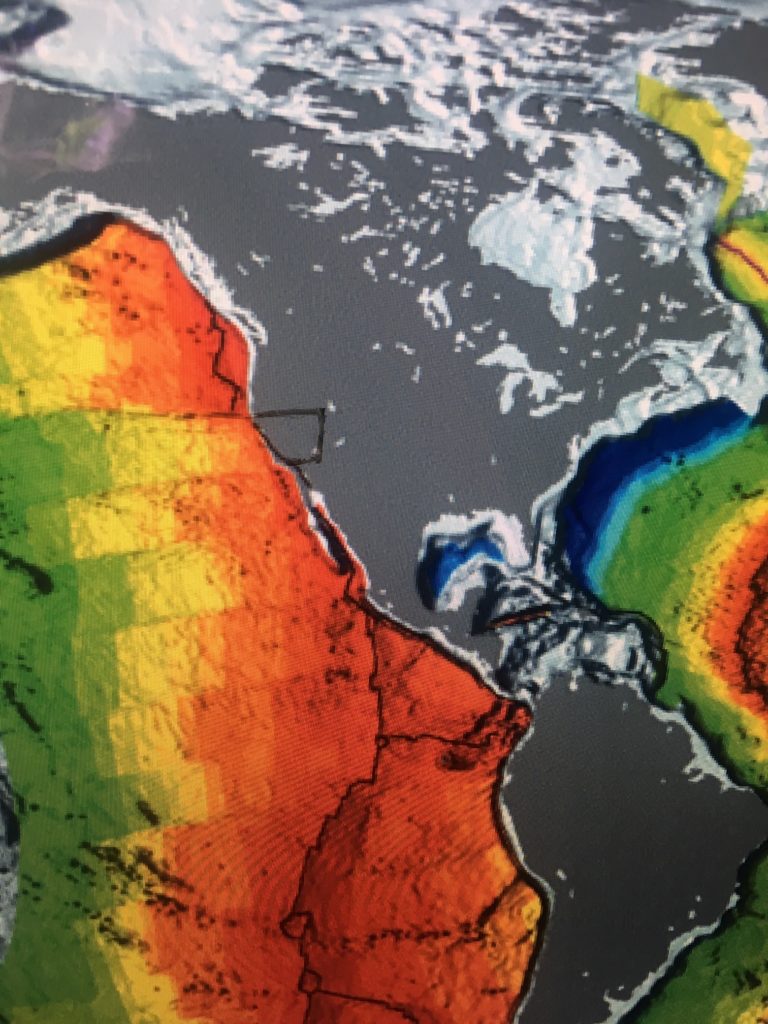
Notice the radial faults stepping evenly on both sides of the expansion fault

The major expansion fault line under the north American plate goes inland to Yellowstone.
The West Coast of the US is an excellent example to study. A fault line map of the ocean floor extending into the Pacific Ocean shows two types of faults. There are radial fault lines and expansion fault lines in this layer of the Earth. The Earth’s rotation causes the radial fault lines. The Earth’s surface at the equator travels 1000 miles an hour. The Earth takes 24 hours at the poles to travel a few inches. It is the tension between these two speeds that causes the radial faults. These faults appear like steps radiating latitudinally from the expansion faults. The expansion faults generally run north-south in the middle latitudes. The radial faults extend equally on both sides of the expansion fault lines. The radial faults are the same length on each side of the expansion faults. These faults give the precise location of the expansion faults hidden under the continent. This method would indicate it goes into the South West, as far inland as Yellowstone.
Push And Pull Forces On The Continents
However, the expansion of the Earth only partially explains the movement of the continents. Earth’s magnetic forces pull the continents toward the poles, especially toward the North Pole. In addition, the rotational motion exerts a pull toward the equator. The smaller globe shows North America’s west coast next to South America’s west coast. The site of Lima, Peru, was once close to Los Angeles
The Explanation For The Dramatic Position-Shift.
The continental landmasses cluster together in an incrementally tighter mass close to the North Pole. Their weight put the Earth’s crust increasingly out of balance. Centrifugal force pulls the continental masses towards the equator. At the same time, gravity depresses them into the sub-crust, and the magnetic pull holds the continental masses in a relatively stable position. The dis-equilibrium is caused by the increasing clustering reached a critical point. The centrifugal force exerted sufficient power on the continental masses to pull them out of the depression in the sub-crust towards the equator. This movement happens suddenly and with great speed.
New Positions
The continents would have moved into new positions on the globe in an attempt to regain equilibrium. The friction of this rapid movement would have liquified the rock between the continental masses and the sub- or ocean plates. The two geologists, Trond Torsvik and Bernard Steinberg, discovered vast formations, thousands of square miles, of pillow lava on the ocean floor that formed simultaneously. The rapid movement of continental masses across the ocean floor would explain this rock formation.
New Ocean Floor
The liquifaction of the rock between the continents and the sub or ocean plates would reset the time clock, as measured through radioactive decay in the lava, back to zero. The repeated sliding of the continental masses would explain why the oldest part of the ocean floor is only 450 million years old, while the continents have much older rock.
New Climates
The continents would have moved thousands of miles in these significant adjustments. This movement would explain some of the dramatic climate changes that happened in Earth’s past. some of
New Mountains
The resistance caused by this motion would have crumpled the continents’ leading edges. Forces of this magnitude created lines of mountains on the continents’ leading edges. These mountain chains would have risen overnight and explain the large bands of metamorphic rock that exist in areas of continental upheavals. However, if one landmass collided, one would ride up on the other. These collisions locked continents together to form a new landmass, only to be broken into smaller landmasses as the underlying sub-crust expanded.
Major readjustments to the continents have happened many times. Older mountain chains indicate the direction of older adjustments of Earth’s equilibrium. As the Earth grew and the space between the continents expanded, the readjustments would have become more dramatic, especially in the last billion years.
Great Dyings
A major readjustment of the Earth’s crust would have caused violent volcanic activity. In addition, the force and speed of the readjustment would have caused an Armageddon-like scenario, releasing vast quantities of iridium from the Earth’s interior. These readjustments would explain some of the Great Dyings in Earth’s history.
When the Earth was smaller, water covered the planet, and the ocean was continuous and deep. As the continents moved apart, water filled the widening voids between them. As a result, the sea above the continents became shallower, allowing animal and plant life to flourish and increase in scale and diversity.
.

Oceanus
Detail of Painting
Detail of Frame
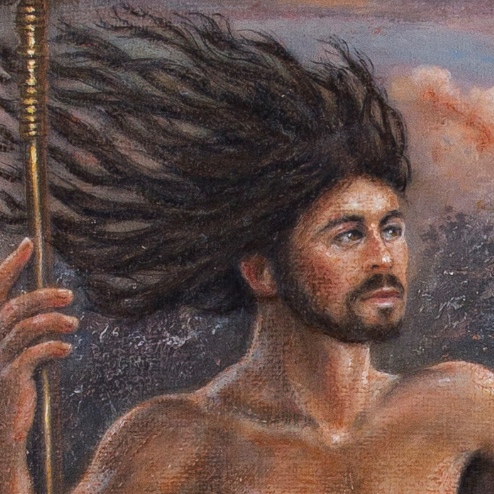

Description of The Painting
The image depicts Oceanus, the Greek Titan, riding the Kraken over the seas as they survey the limitless ocean surrounding the Earth, a time before continents rose from the depths. (See Titan’s π.) It’s a captivating combination of mythology and science.
Earth was born in a crucible of extreme temperatures and pressures that are beyond our comprehension. It began as a dense, tiny, misshapen lump with ice mixed into its fabric—but not the ice we know today. Under the influence of pressure, heat, and cold, water metamorphosed into a crystalline material that was annealed and had properties like diamonds do today. The following chart vividly demonstrates how water’s properties change under pressure and temperature. Temperatures and pressures were more extreme than the limits of the scales of the chart shown here.
The changing pressure and temperature of the past caused Earth’s water to change like a chameleon. Today, we still have a vestigial memory of water’s past. Superheated steam continues to rise from the Earth’s interior, often escaping through the openings created by Volcanoes and faults.
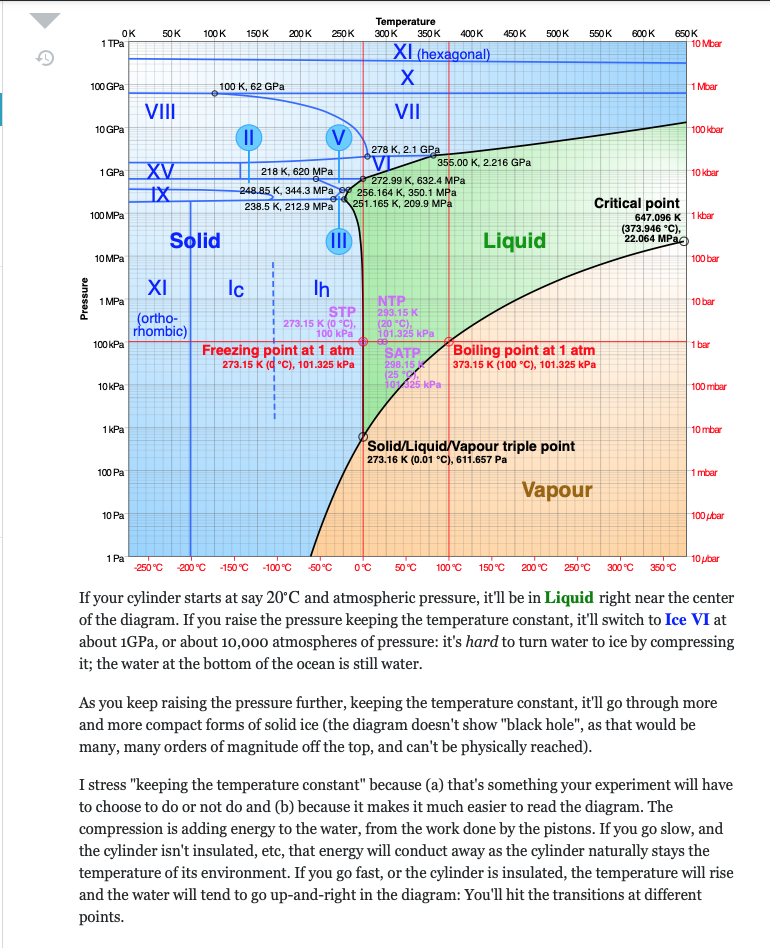
Aotearoa's Tears
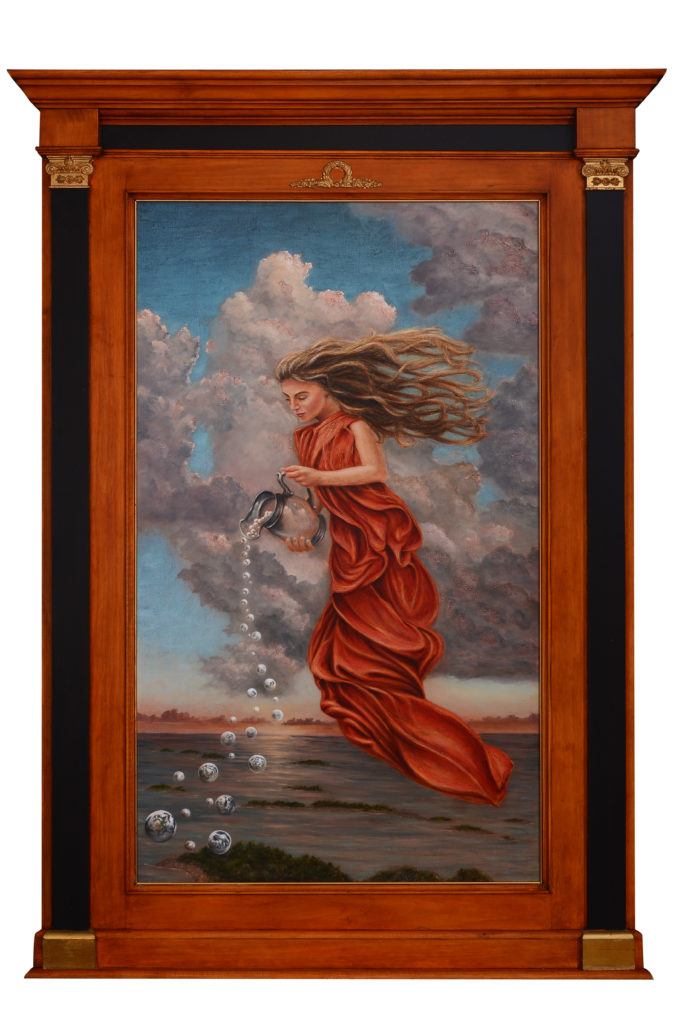
Detail of Painting
Detail of Frame
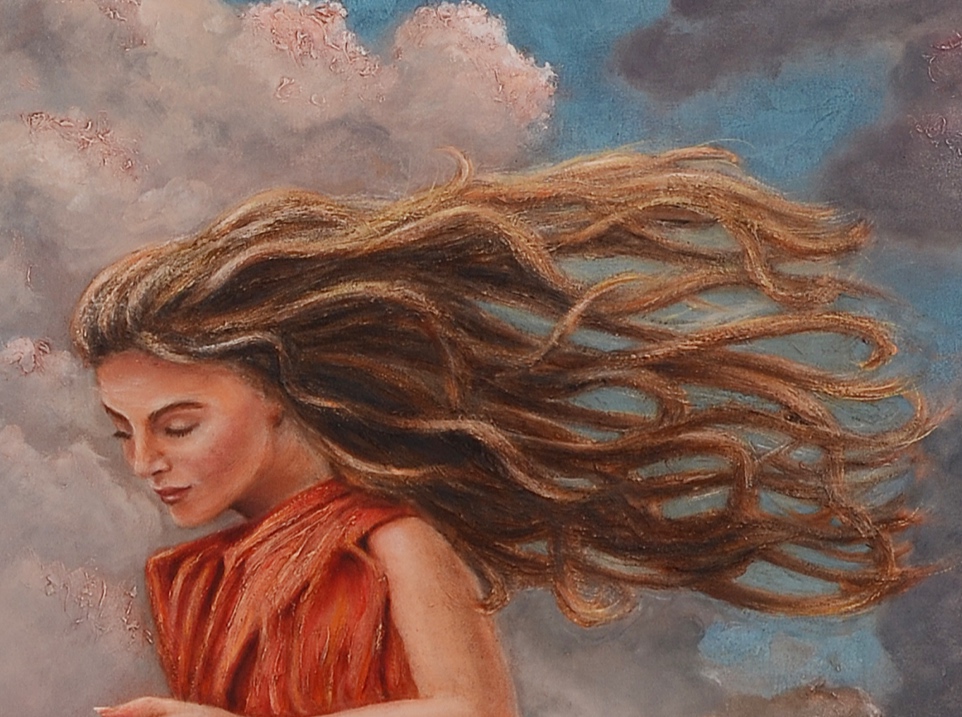
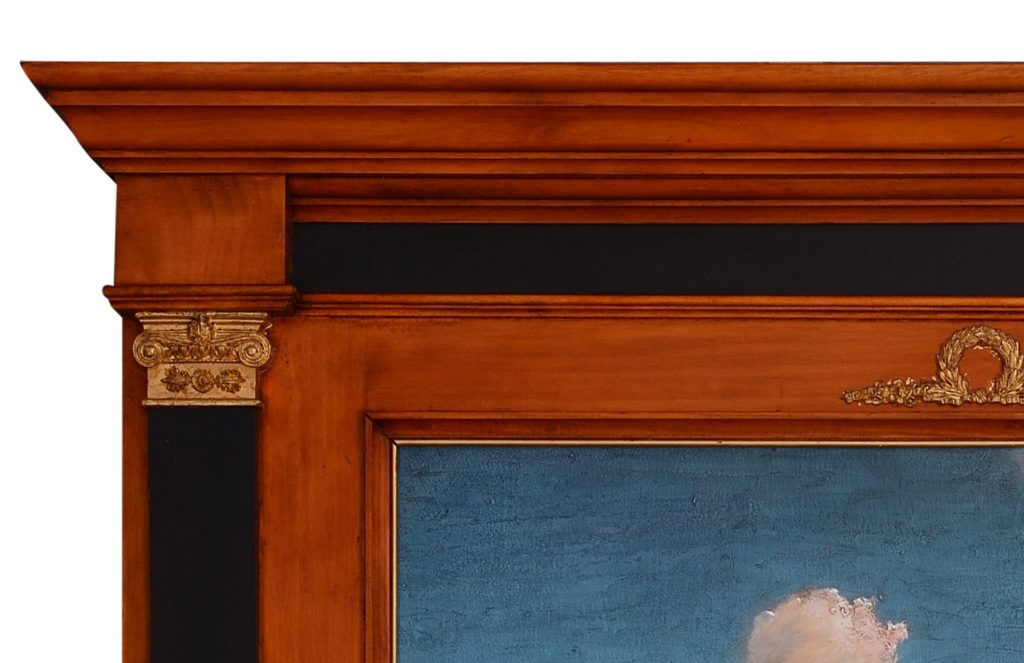
“Aotearoa’s Tears” commemorates the continents of New Zealand and Australia. It shows Aotearoa( Long White Cloud” in Maori) pouring her tears from heaven. As the tears fall, they break apart and become the Earth and the Moon. This painting shows a time in Earth’s past when the highest peaks of mountain ranges under the ocean first appeared above the water. The painting also hints at the origin of mountain chains.
Land Ho
In its early history, a vast ocean enveloped Earth. The Earth was expanding, causing the ocean floor to split apart. Ocean water filled these voids, resulting in the sea becoming shallower above what were to become the continents. “
Continents are constantly moving, and continents move dramatically every sixty to a few hundred thousand years. It is this movement that creates folded mountains. These mountains form on the leading edges of continents when they rapidly change positions. Older chains like the Appalachians indicate North America moved dramatically from west to east before repeated westward movement formed the western ranges. Collisions between continents, causing one plate to rise over another continent, gave rise to the highest mountain chains in areas like Tibet and Nepal. The Earth has been expanding with the universe for billions of years, becoming the planet we know today. (see Titian’s Pi.)
The Moon
The Earth and the Moon initially formed one planet. They may not have initially been spherical, as depicted in the image of an asteroid that could resemble the shape of this early Earth-Moon.

The centrifugal force might have caused the Earth-Moon to break apart, similar to the breaking apart of an unbalanced flywheel. Speed variations cause objects that spin like the Earth to experience tensions between the axis, the poles, and the surface. The maximum speed difference is between the equator and the pole axis. The following image of the Sun shows the type of tension experienced by the Earth. This speed difference is a constant stress on the Earth. Rotational faults, usually called radial ones, radiate from more prominent expansion faults.
The breaking up of the original unbalanced planet may have been logically caused by rotational tensions, leading to the catastrophic separation. This event would have been a monumental upheaval in the planet’s history, explaining the early volcanic activity on the oldest continental landmasses.
Our celestial companion, the Moon, is a marvel in motion, gradually distancing itself from its larger twin, Earth. The current distance to the Moon is 238,857 miles, increasing by 1/2 of an inch per year, 237,000 in a billion years, presuming the rate was constant. But the rate has slowed. Calculating the increase in distance between the Moon and the Earth back billions of years indicates the two spheres were once joined.
Morgana Le Fay or Fata Morgana

Detail of frame
Detail of Painting
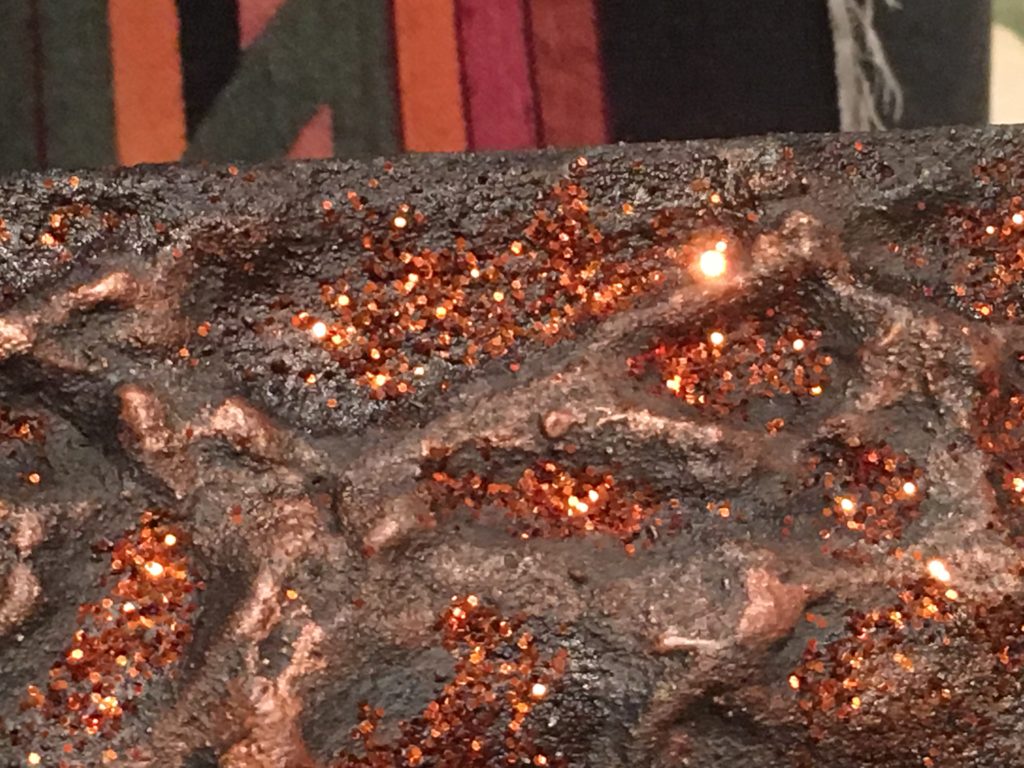

Description of Painting
The painting started as a sketch of my model Elissa. It was drawn in a continuous line without lifting the pencil. Subsequently, quick strokes with the broadside of a graphite stick defined the shading. This method, of course, resulted in the sketch having sensuality and freedom.
Transferring The Sketch To Canvas
I transferred the drawing to the canvas without changing or correcting proportions to preserve the freedom and sensuality of the original drawing. I reproduced the continuous line using a cake decorator filled with paint and then applied pieces of lace to represent the shadows. Once the painting was on the canvas, it took on a life of its own. Elissa became a goddess of fire and molten stone.
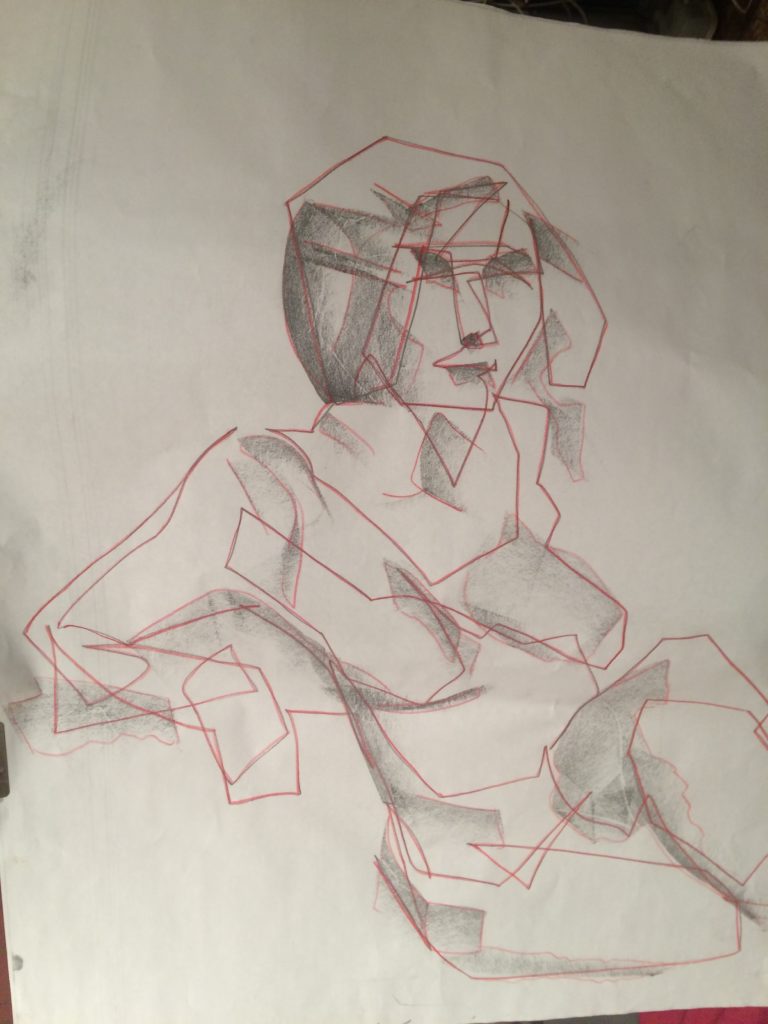



The Meaning Of The Name
Fata Morgana signified a nautical mirage. In Ireland, it was part of an old legend. People claimed they could sometimes see a lost land and a city far west in the Atlantic. They called the island city O Breasal or Hy Brazil. Its name meant Royal City or the island of the blessed. (Curiously, a name much older than the Portuguese name for the country.) They saw an apparition on the sea with people running to and fro between flames.
Fata Morgana rests in the painting after one of her frantic, fiery marathons. Fata Morgana represents the Earth’s volcanic past and future.
What Is Hot? What Is Cold?
The Earth has experienced intense periods of volcanic activity. It is widely believed that the Earth started as a hot, molten rock and has been slowly cooling. The features of the Earth’s land and ocean surfaces, as do the extensive pillow lava formations on the ocean floor and mountains made of igneous and metamorphic rock, provide evidence for this theory. Despite its cooling appearance, gradual heating may still occur, potentially leading to increased volcanic activity following significant seismic events.
The theory suggests that continents moved rapidly over long distances, causing the creation of extensive pillow lava formations over thousands of square miles. These upheavals throughout Earth’s history have increased in magnitude. According to “The Expanding Earth Theory,” 60 to 200 million years intervals allow the Earth’s surface to cool before undergoing another significant transformation. Fata Morgana might be a prediction of Earth’s future.
Earth’s ancient history suggests that it may have formed initially as a frozen mass of rock and ice, which is truly awe-inspiring. The immense pressure from the Big Bang could have significantly influenced the behavior of matter and liquids, such as water, potentially allowing water to remain with Earth as it cooled. Water might have frozen at temperatures much higher than today’s boiling point due to the tremendous pressure exerted during the Big Bang. After billions of years without a direct heat source following the Big Bang, the ancient Earth would have started cold, resulting in the Earth forming with most of its water. This same composition is present in numerous meteors and comets that come close to Earth, further contributing to the planet’s ancient and awe-inspiring history and mystery.
Where Does Heat Come From
The Earth, a dynamic and ever-changing entity, is not just a recipient of warmth from the Sun, but also generates its own heat through internal forces. The Earth’s rotation and expansion cause friction, thereby generating heat. These internal forces manifest as rotational tensions and fractures, visible in the longitudinal faults that form steps and radiate out from the expansion fault lines. These expansion faults, encircling the globe, are a vital area of study for geologists, highlighting the Earth’s connection to the larger celestial system.
The tension of the equator moving at 1,000 miles an hour and the poles almost motionless creates heat. Similarly, the internal forces between the different layers of the Earth, which move at different speeds, are a crucial aspect of geological research. The internal imbalance in speed creates tension that builds up to a final release, leading to earthquakes.
Heat is created internally by the friction of expansion and rotation. The internal expansion produces volcanic activity along the expansion faults.
Additionally, the onion-like layers slide independently, causing heat. The volcanic mounts that have moved across the Pacific Ocean from Asia to Hawaii illustrate the upwelling of material to the surface layer from the movement of a layer below the ocean floor.
As our planet rotates, it experiences internal stresses that result in surface and internal cracks, as well as slippage between the layers of the Earth’s core. Check out https://citeseerx.ist.psu.edu/document?repid=rep1&type=pdf&doi=24e384acbb0aaa762da1c529921c461ba4eba353 or https://www.sciencedirect.com/science/article/pii/S0020768304006286 for more information.
The Future
The Earth’s seismic and volcanic history indicates future catastrophic events. The movement and re-balancing of the continents could occur at any time, even if it takes millions of years for such significant changes to happen. Currently, with most continents clustered near the north pole, the planet is out of balance, and this imbalance could lead to unpredictable outcomes.
As the Earth grows more significant and distances between landmasses increase, the re-balancing of the Earth’s crust becomes more dramatic. This increase in distance suggests that the next major shift will likely be more catastrophic than previous ones. While some adjustments may be relatively mild, the last major shift occurred approximately 65 million years ago. It resulted in the extinction of the majority of the dinosaurs, as well as widespread devastation to plant and animal life. To potentially save the planet, it may be necessary to construct a version of Noah’s ark containing a diverse range of species to repopulate the Earth after such an event. Due to the potential inhospitable nature of the Earth for at least a generation following such a cataclysmic event, it might be feasible to consider building an ark, possibly on the Moon, to sustain life and humanity.
Charts Of Previous Mass Extinctions

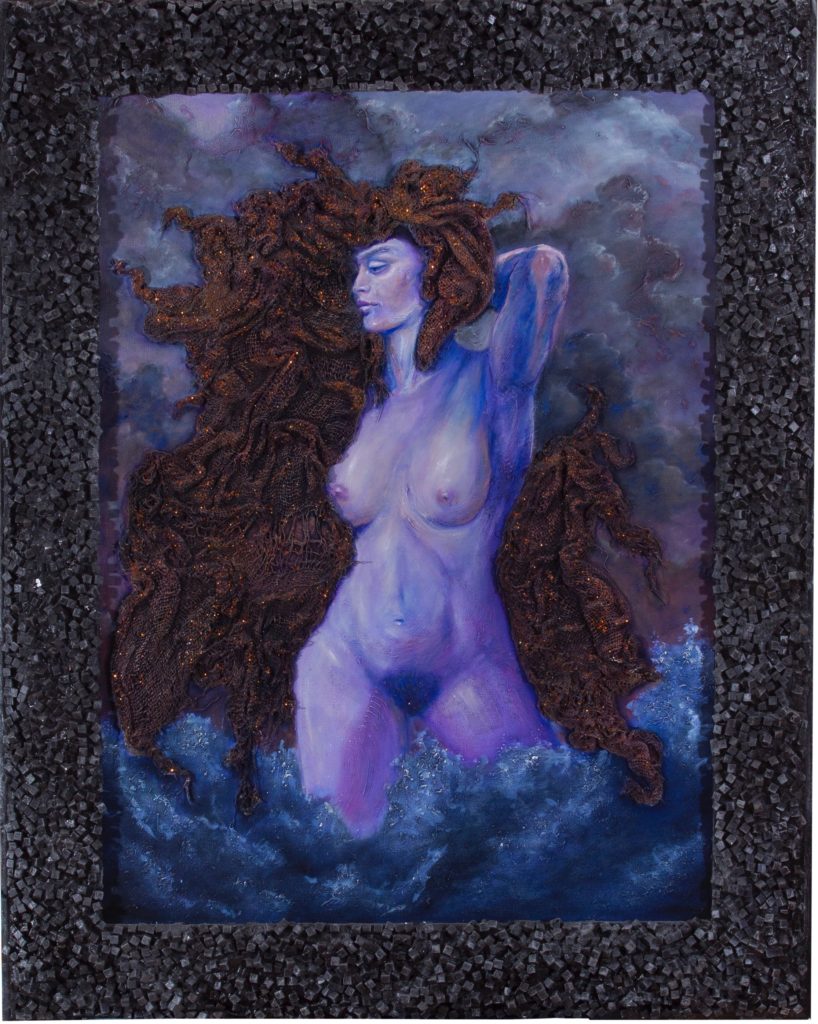
Kym Opolaya
Description Of Painting
The painting depicts Kym Opolaya, a Greek goddess of ocean storms and violent waves billions of years ago, walking in the shallows as the land emerges. The artwork was inspired by Elissa, a favorite model known for her long, luxurious hair who always takes poses of grace and strength poses. She inspired the direction of the painting.
From The Drawing To The Painting
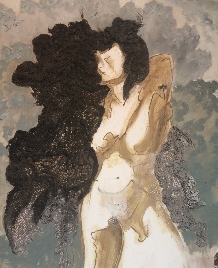

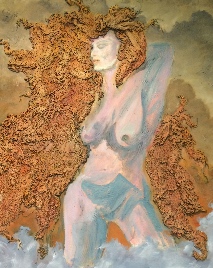
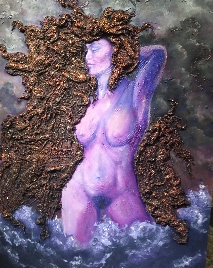

Detail Of The Frame Which Was Inspired From A Hematite Crystal Cluster
Detail Of The Frame
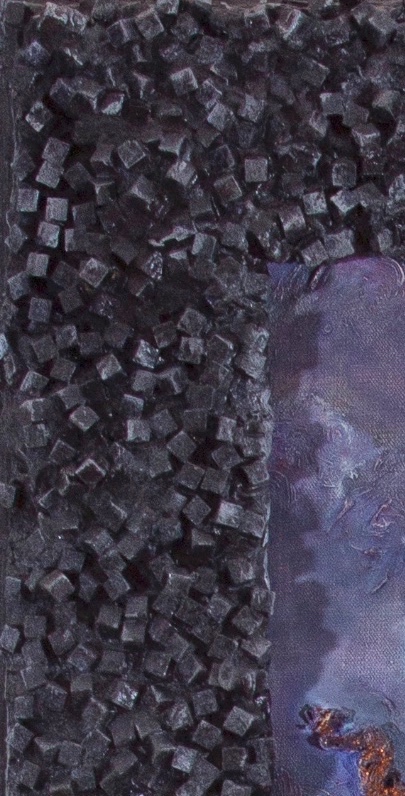
The Theory Of A Water Planet
The Earth’s surface is covered by water, accounting for seventy-one percent of the total, suggesting that the Earth could be named “Aqua.” Billions of years ago, this name would have been even more fitting, as the Earth was considerably smaller and enveloped in water. The conditions were vastly different, with temperatures and atmospheric pressures reaching staggering levels. Water reacted in ways that are impossible to replicate today. It may have required temperatures above 300°C to boil at high temperatures and extreme atmospheric pressure and could have frozen at equally high temperatures. Early ice/water may have resembled a mineral on the early Earth, crystalline and harder than diamonds. As temperature and pressures slowly adjusted to today’s levels, this mineral ice transformed, eventually becoming the liquid, ice, and vapor found on Earth today. The adaptability of water as a substance is genuinely remarkable.
Add Your Heading Text Here
Water Properties With Pressure and Temperature Changes
Water on Earth


Globes of The Small and Expanded Earth

Here are two globes; one is the Earth today, and the smaller is a model of the Earth from the distant past. Today’s world was used to trace the continents, including their continental shelves. These tracings were then applied to a globe about 30 percent the size of the Earth today. Surprisingly, the tracings e fit perfectly on the smaller world. There was no overlapping and only minor gaps where continents shredded as they broke apart. This shredding led to the creation of many islands. The quantity and small size of the islands made reconstructing areas like the East and West Indies difficult. These issues were minor and did not affect the precise fit of most areas of the continents on the more miniature globe. This accurate fit is a significant challenge to the current plate tectonics and subduction theory.

Four Views Of TheYoung Earth

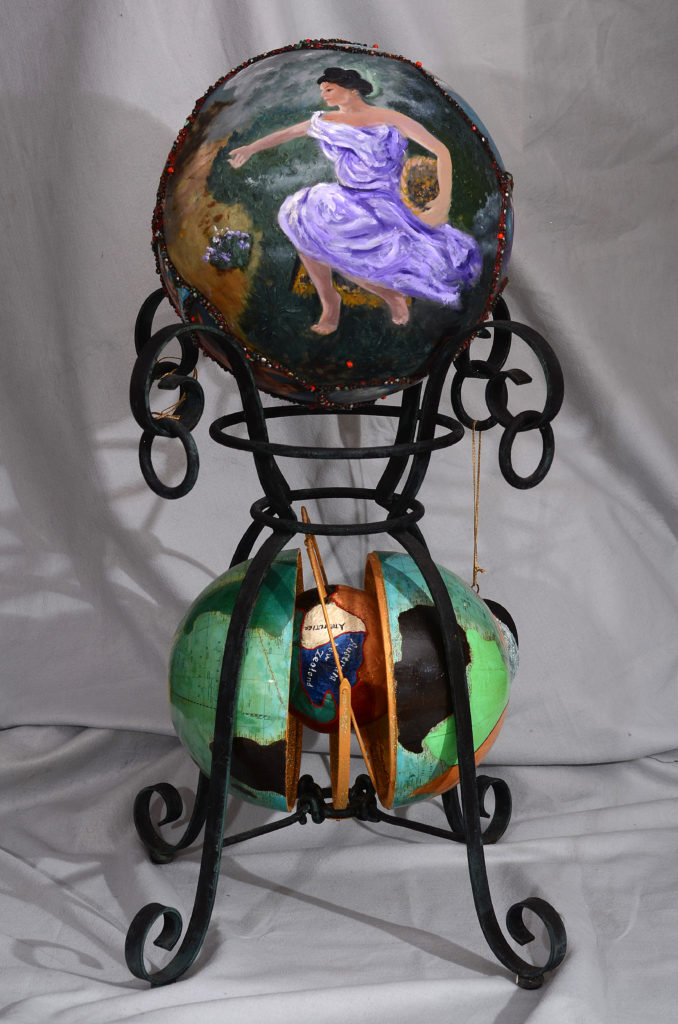

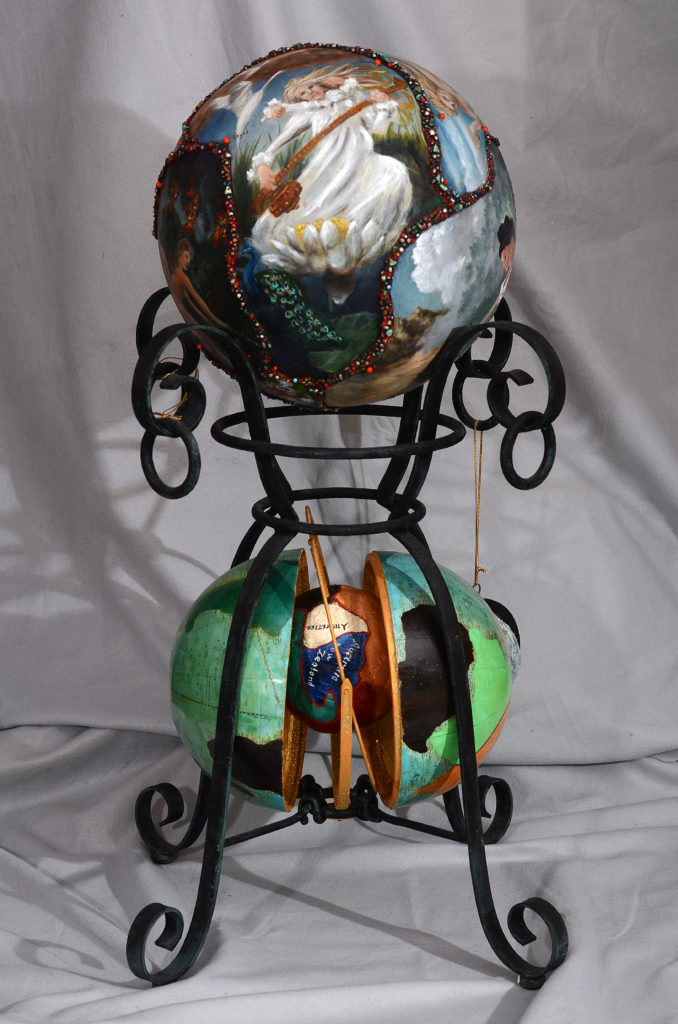
Early Earth Inside Today's Earth For A Sense Of Scale
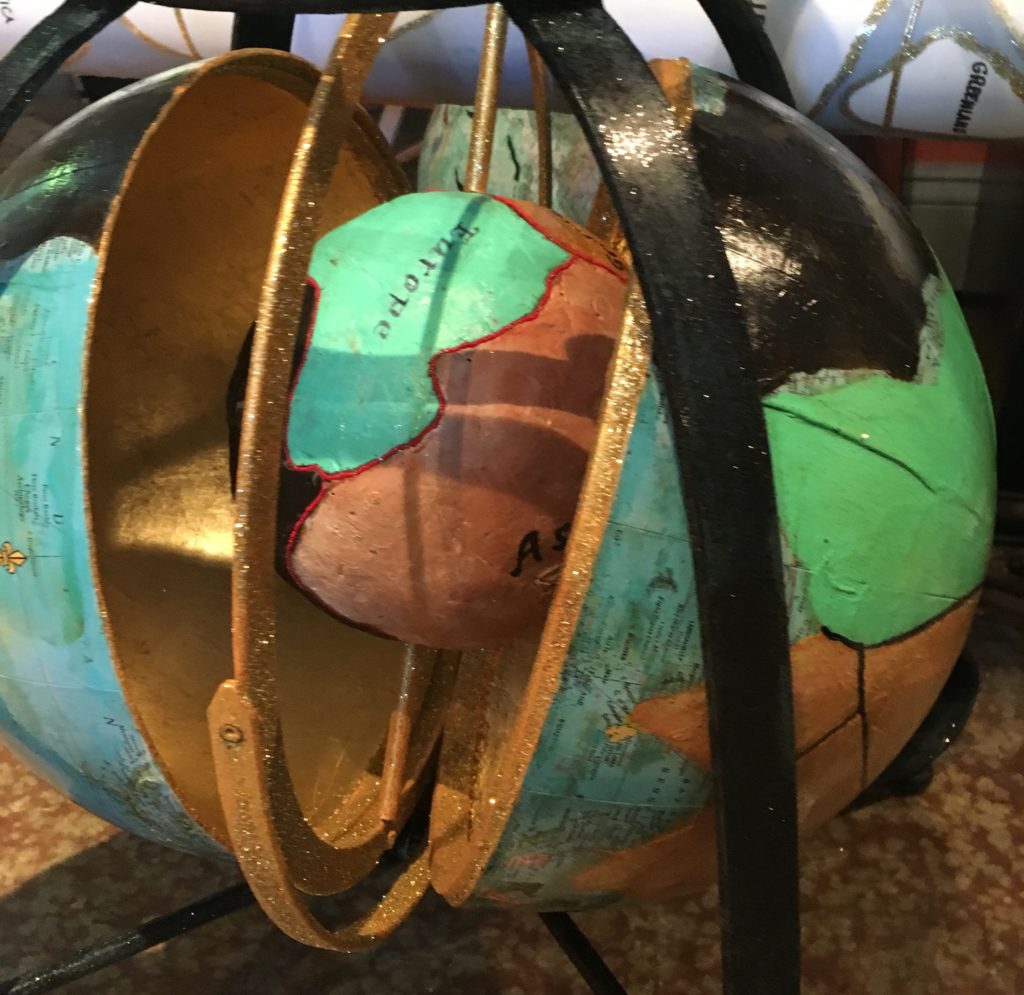
The Expanding Earth Theory, http://teddeclercq.com/expanding-globe-theory/, gives an alternative explanation for the tremendous geological catastrophes. Periodically, continents shift their positions dramatically and rapidly, creating massive volcanic activity, mountains, and vast expanses of pillow lava on the ocean floor. It is this repeated event that most likely caused the Great Dyings.
Crater's Cradle
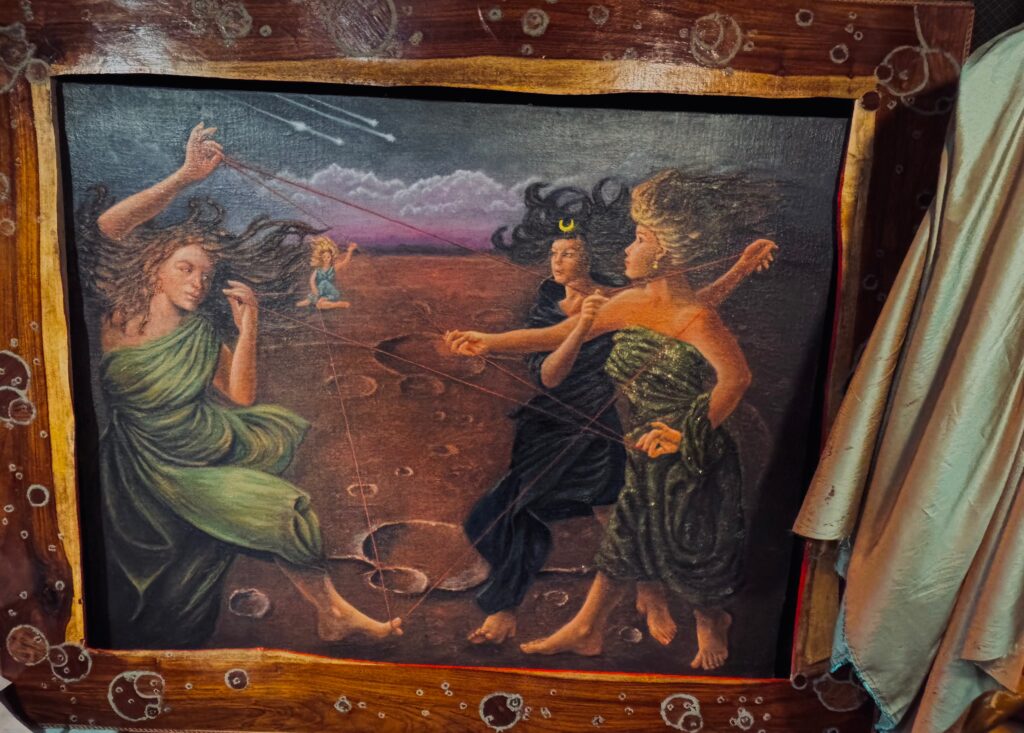
Crater’s Cradle is not finished. This image shows the current state of the painting and frame.
The painting depicts four women on the windswept surface of a cratered planet, beginning a game of Cradle. As they stretch a string for their play, they notice how the craters around them tell a story. These circular impressions are arranged by age, with the oldest being the largest.
Pattern Of Meteor Strikes
The pattern of craters found on planets and asteroids offers invaluable insights that significantly deepen the understanding of both Earth’s history and the broader cosmos. The pattern is visible on planets, moons, and asteroids. On Earth, erosion and volcanic activity have obscured much of the craters’ history, but recent events suggest their likely cause.
Crater Analysis Rewrites Geological History
The Sequence of Crater Creations
The illustration below, illustrates the consistent sequence of crater formation observed across all visible planets and asteroids. A detailed examination of any cratered surface reveals a compelling pattern: smaller craters invariably overlap larger ones. In stark contrast, the scenario depicted in the top right—where a larger crater overlaps a smaller one—has never been observed on any celestial body.
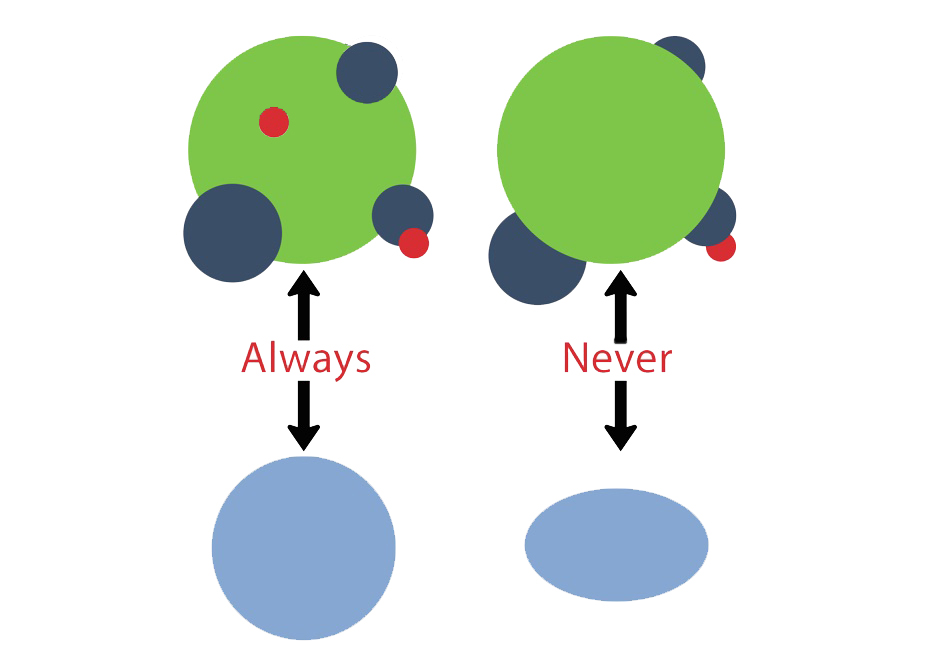
An additional feature shown in the diagram is that craters are always close to round and never take on an elliptical shape. Craters are predominantly circular, revealing a striking consistency that underscores the geological uniformity across various terrains on planets moons and asteroids. When meteors and comets traverse the Earth’s atmosphere, they typically enter at an oblique angle and often fragment during their descent. This fragmentation would lead to debris scattered over extensive areas, much like the spectacular disintegration of Skylab, which sent fragments across hundreds of miles of the Indian Ocean and Western Australia. Even if some asteroids and meteors manage to remain intact as they pass through the atmosphere, it is illogical to assume that their impacts will always produce circular craters instead of elliptical ones. This consistent circularity ocurrs on planets and moons with and without atmospheres, raises intriguing questions about the nature of impact events and the forces at play in our planet’s geological processes.
Earth must have followed this same sequence of events in its geological history.However on Earth, erosion and volcanic activity have obscured many ancient craters. In contrast, other planets and moons in our solar system have undergone much less erosion, allowing their crater formations to remain more visible. Interestingly, these craters display a distinct pattern that challenges the notion of random distribution: larger craters tend to be older, and in every case observed, larger craters do not overlap with smaller ones. It is logical to assume that Earth would have experienced the same sequence.
Small projectiles ejected during the formation of the larger crater could account for the smaller craters on its surface. However, this hypothesis leads us to a significant implication: certain large craters should overlap other existing crater sites. Yet, as just observed, this overlap is conspicuously absent in our observations. Leading to the reasoning that small craters do not result from the creation of large craters.
Here are a few examples in the photographs of craters showing how they overlap. In the second photo a few examples are circled in red .
Pictures of Craters Showing How They Overlap
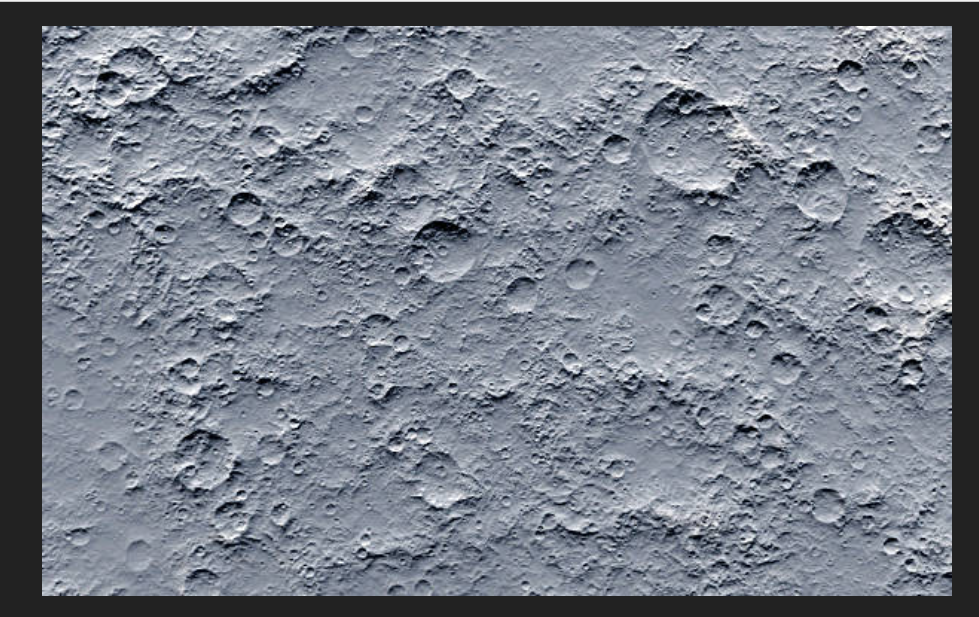

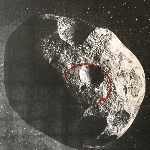
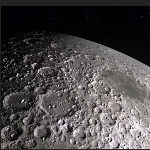
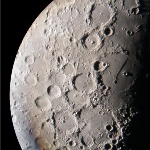
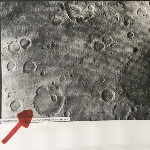
The picture on the right is one of the few cases where the smaller crater seems to be superimposed by the larger one. However, on close examination, the edges indicate that the smaller crater was made after the larger one.
Craters shown on an asteroid and in the picture on the left show similar indentations in the order of craters to those found on planets and moons.
CIRCULAR DEPRESSIONS
Craters are circular. An impact trajectory would have always had to be 90 degrees to the Earth.
Nevertheless, most photos show meteors’ paths at a low angle, which would create an elliptical impact depression.
Pictures of meteor strikes, notice the low-angle
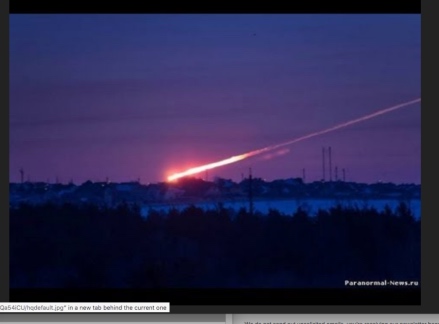
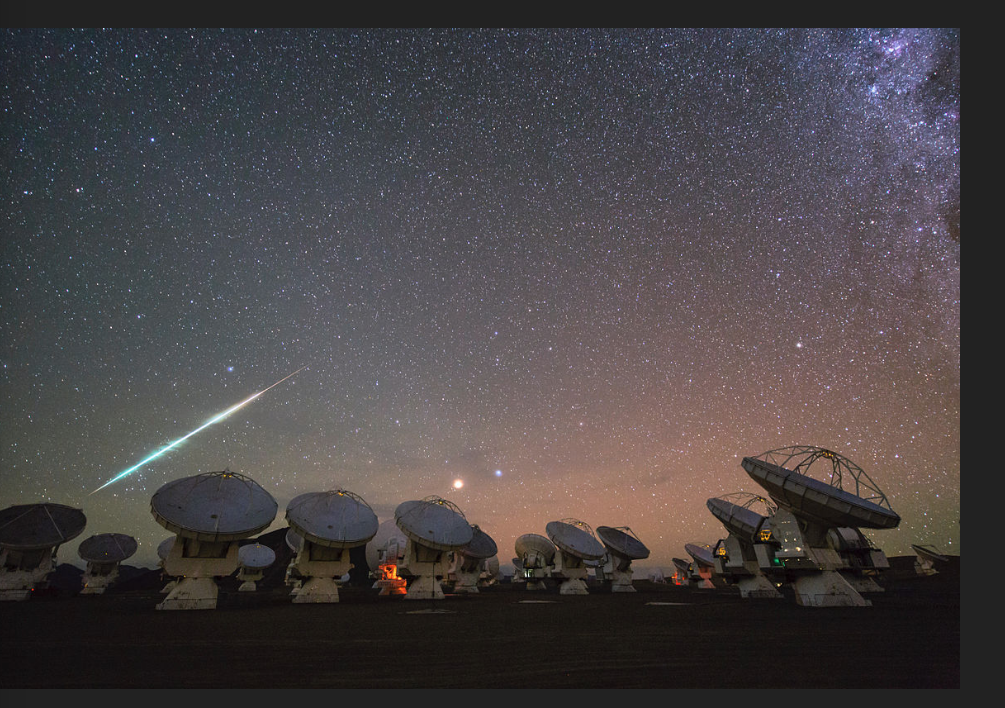
Craters In The Arctic Caused By Methane Explosions
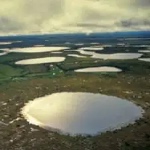
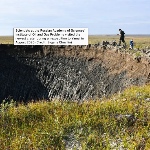

However, craters caused by explosions from within the planets or moons would be circular. Many substances, like water and methane, could cause these eruptions.
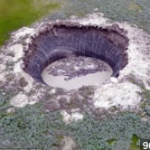
Cause of Craters
Craters on planets and moons form as a result of powerful internal explosions or eruptions rather than the more commonly believed impacts from meteors or comets. These explosive events can be fueled by substances such as H2O, water, or CH4, methane, indicating a fascinating and dynamic geological process occurring beneath the surfaces of celestial bodies. Methane is continuously released from the Earth, often in sudden bursts, as observed in regions like Siberia and northern Canada. As the climate warms and ice and permafrost melt, methane trapped beneath the ice is released suddenly, resulting in violent explosions.
Craters on planets and moons often form as a result of powerful internal explosions rather than the more commonly believed impacts from meteors or comets. These explosive events can be fueled by substances such as water or methane, indicating a fascinating and dynamic geological process occurring beneath the surfaces of celestial bodies. For instance, methane is continuously released from the Earth, often in sudden bursts, as observed in regions like Siberia and northern Canada. As the climate warms and ice and permafrost melt, methane trapped beneath the ice is released suddenly, resulting in violent explosions.
Pictures of Methane Explosions in the Arctic

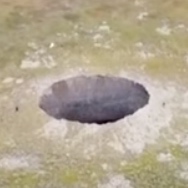
Water can exist in three states on Earth: liquid, solid, and gas. Solid water, known as ice, forms at or below 0°C (32°F). However, pressure can affect the temperature at which these different states of water remain stable. Under certain conditions, increased pressure can transform water into a solid material with a structure entirely different from Earth’s ice.
In space, where we have measured temperature, it is approximately 2.7 Kelvin, which equals -455 degrees Fahrenheit or -270.45 degrees Celsius. The pressure in outer space is extremely low, close to a perfect vacuum, measuring about 1.322 × 10^−11 Pascals. It is important to note that this is not a perfect vacuum, and space density may vary significantly, both within our solar system and between galaxies. Additionally, this low pressure has likely changed dramatically as the universe has expanded. As temperature and pressure fluctuate in space, water and other materials may rapidly convert to gas, potentially causing them to explode from asteroids and meteors, contributing to their pocked appearance.
The Massive Extinctions of the Past

Astronomers warn that Earth could potentially experience a catastrophic meteor strike that might obliterate life on the planet, referencing past events where similar occurrences led to massive extinctions. While other factors have also contributed to significant die-offs in history, as discussed in Titan’s π on this site, it is currently unlikely—if not impossible—that a large meteor will impact Earth in the foreseeable future.